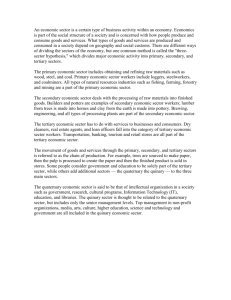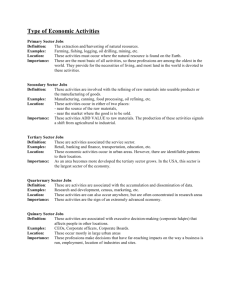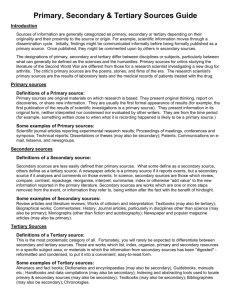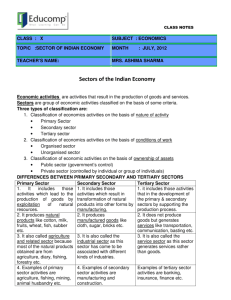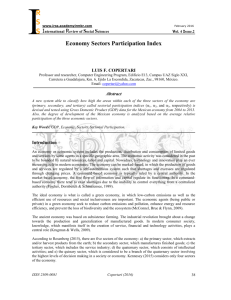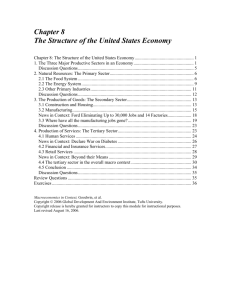class x chap2 notes
advertisement
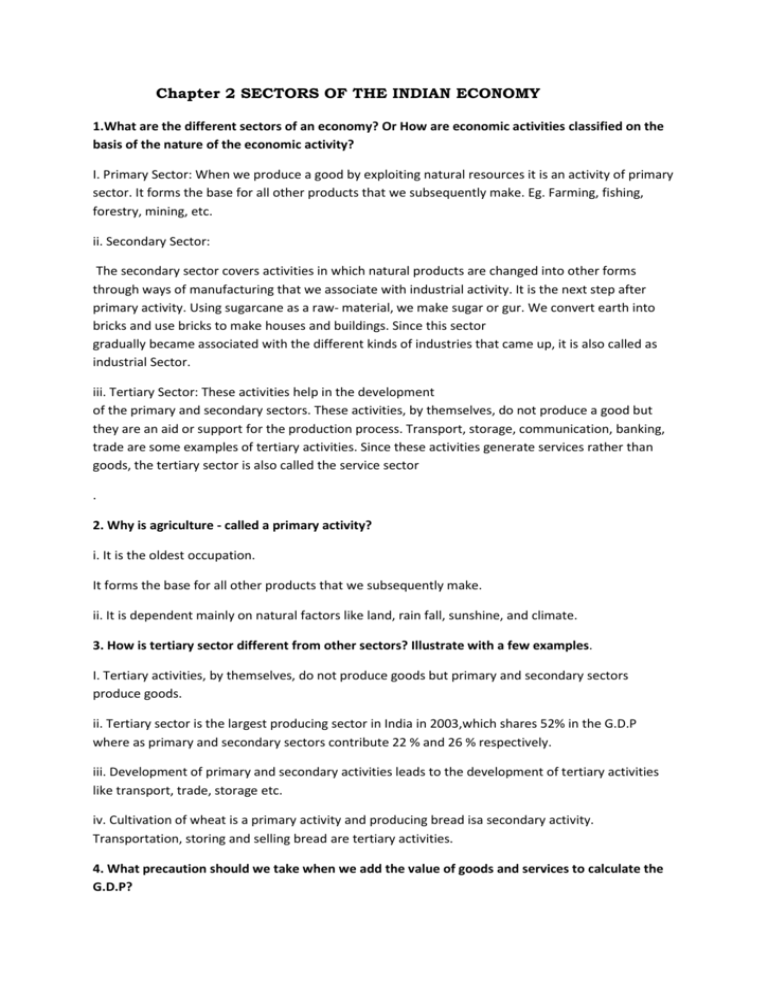
Chapter 2 SECTORS OF THE INDIAN ECONOMY 1.What are the different sectors of an economy? Or How are economic activities classified on the basis of the nature of the economic activity? I. Primary Sector: When we produce a good by exploiting natural resources it is an activity of primary sector. It forms the base for all other products that we subsequently make. Eg. Farming, fishing, forestry, mining, etc. ii. Secondary Sector: The secondary sector covers activities in which natural products are changed into other forms through ways of manufacturing that we associate with industrial activity. It is the next step after primary activity. Using sugarcane as a raw- material, we make sugar or gur. We convert earth into bricks and use bricks to make houses and buildings. Since this sector gradually became associated with the different kinds of industries that came up, it is also called as industrial Sector. iii. Tertiary Sector: These activities help in the development of the primary and secondary sectors. These activities, by themselves, do not produce a good but they are an aid or support for the production process. Transport, storage, communication, banking, trade are some examples of tertiary activities. Since these activities generate services rather than goods, the tertiary sector is also called the service sector . 2. Why is agriculture - called a primary activity? i. It is the oldest occupation. It forms the base for all other products that we subsequently make. ii. It is dependent mainly on natural factors like land, rain fall, sunshine, and climate. 3. How is tertiary sector different from other sectors? Illustrate with a few examples. I. Tertiary activities, by themselves, do not produce goods but primary and secondary sectors produce goods. ii. Tertiary sector is the largest producing sector in India in 2003,which shares 52% in the G.D.P where as primary and secondary sectors contribute 22 % and 26 % respectively. iii. Development of primary and secondary activities leads to the development of tertiary activities like transport, trade, storage etc. iv. Cultivation of wheat is a primary activity and producing bread isa secondary activity. Transportation, storing and selling bread are tertiary activities. 4. What precaution should we take when we add the value of goods and services to calculate the G.D.P? i. Not every good (or service) that is produced and sold needs to be counted. It makes sense only to include the final goods and services. ii. Take, for instance, a farmer who sells wheat to a flour mill for Rs8 per kg. The mill grinds the wheat and sells the flour to a biscuit company for Rs 10 per kg. The biscuit company uses the flour and things such as sugar and oil to make four packets of biscuits. It sells biscuits in the market to the consumers for Rs60 (Rs 15 per packet). Biscuits are the final goods, i.e., goods that reach the consumers iii. To count the value of the flour and wheat separately is therefore not correct because then we would be counting the value of the same things a number of times. 5. What are intermediary goods? Why is its value not added to the G.D.P? i. Intermediate goods are the goods used in the production of a final product. We use wheat, then its flour to produce bread. These are intermediary goods. ii. The value of final goods already includes the value of all the intermediate goods that are used in making the final good Hence, value of all other intermediate goods would have been included. To count the value of the flour and wheat separately is therefore not correct because then we would be counting the value of the same things a number of times. 6. What is G.D.P? How do we count the various goods and services for calculating GDP? Explain with examples. i. It is the market value of all final goods and services produced within a country during a particular year. The value of final goods and services produced in primary, secondary, and tertiary sectors during a particular year provides the Gross Domestic Product (GDP) of a country. ii. The great task of measuring GDP is undertaken by a central government ministry. This Ministry, with the help of various government departments of all the Indian states and union territories, collects information relating to total volume of goods and services and their prices and then estimates the GDP. Examples same as Answer 4 above Q.7 What is the differences between public and private sectors? Ans. Public Sector Private Sector (i) The government owns most of (i) Ownership of assets and delivery the assets and provides all the of services is in the hands of private services. individuals or companies. (ii) The purpose of the public sector (ii) Activities in the private sector are is not just to earn profit, but also to guided by the motive to earn profit. raise the welfare of the economy. (iii) Tata Iron and Steel Company (iii) Railways or post office is an Limited or Reliance Industries limited example of the public sector. are privately owned. Q.8 What is the meaning of under employment? In which economic sector is under employment conditions more prevalent? &Why? Ans : A condition in which each individual appears working but no one is fully employed. This is the situation of under employment. People under such type of employment cannot utilize their potential and capacity in full. Give example of agriculture sector. It is in primary sector because(i) This sector comprises the poorest section of society in majority (ii) People engaged in this sector are illiterate or semi-literate. Q.9 What is the differences in the employment conditions between organized and un-organized sectors of the economy? Ans : Organized sector Un-organized sector 1. Registration with the government. 1. No such registration with the 2. The labourers are expected to work for government. a fixed number of hours. 2. There is no fixed working hour. 3. The wages are fixed and extra 3. The labours get daily wages. payment for extra work [overtime]. 4. There is not any such benefit. 4. In addition to wages, people get some 5. There is no job security. extra benefits like paid leaves, provident 6. There is no such provision of fund, gratuityetc. appointment letter. 5. There is a job security. 6. The labours are given an appointment letter stating all the terms and condition of work. 10. What do you understand by GDP of a country ? The value of final goods and services produced in each sector during a particular year provides the total production of the sector for that year And the sum of production in the three sectors gives what is called the Gross Domestic Product (GDP) of a country. It is the value of all final goods and services produced within a country during a particular year. 11 Give reasons for the Rising Importance of the Tertiary Sector in Production 1. In any country several services such as hospitals, educational institutions, post and telegraph services, police stations, courts, etc. are required. These can be considered as basic services.In a developing country the government has to take responsibility for the provision of these services. 2 Second, the development of agriculture and industry has led to demand of more services such as transport, trade, storage etc 3 Demand for more specified services such as eating out, tourism, shopping, private hospitals,private schools, professional training etc 4. Over the past decade certain new services such as those based on information and communication technology have become important and essential. The production of these services has been rising rapidly. 12. HOW CAN WE CREATE MORE EMPLOYMENT? There are various ways in which govt. can create employment opportunities as… 1.The govt. can spend some money or banks can provide loans to construct well etc. Which will reduce the dependency of farmers on rains, and they will be able to grow two crops a year. 2.Construction of Dams and Canals can lead to lot of generation of employment in agricultural sector itself. 3.If govt. invests some money on transportation and storage of crops or makes better rural roads, it can provide productive employment to other who are in services like transport or trade. 4. If local banks give credits at reasonable rates to the small and marginal farmers, they will be able to buy necessary inputs for their crops in time. 5. Another way to solve this problem is to identify, promote and locate industries and services in the semi-rural areas to provide alternative employment 6. Similarly to provide education to all children we would need lot of schools which can also generate employment. 7.Tourism:every state or region has the potential for increasing the income and employment. 13. Write a short note of NREGA—2005. National Rural Employment Guarantee Act 2005 was started by the Central govt. In this government made a law implementing Right to work in 200 districts of India initially. Now it has been implemented throughout It ensures all those who are in need of work will get guaranteed 100 days work and if the govt. fails to do so, it will give unemployment allowances to them. The work will of the type which will in future help them to increase income infuture also.

